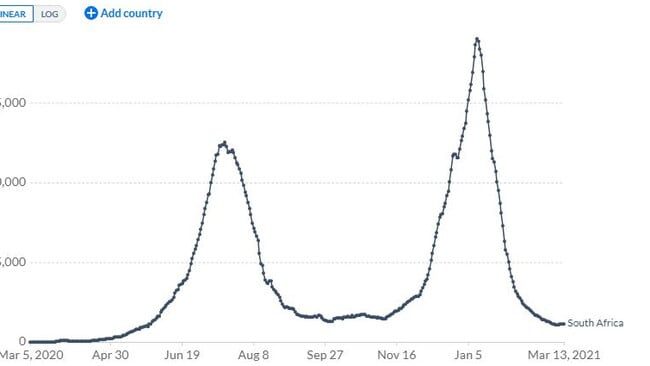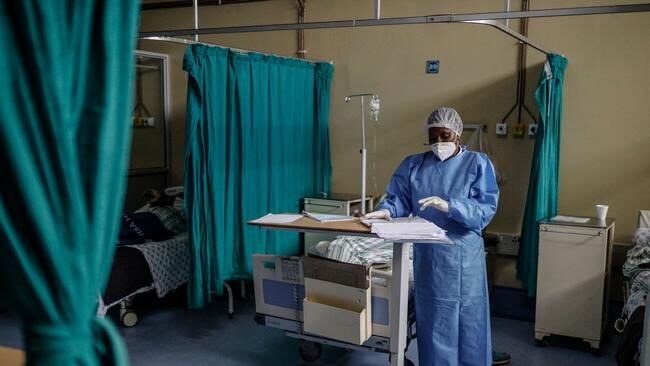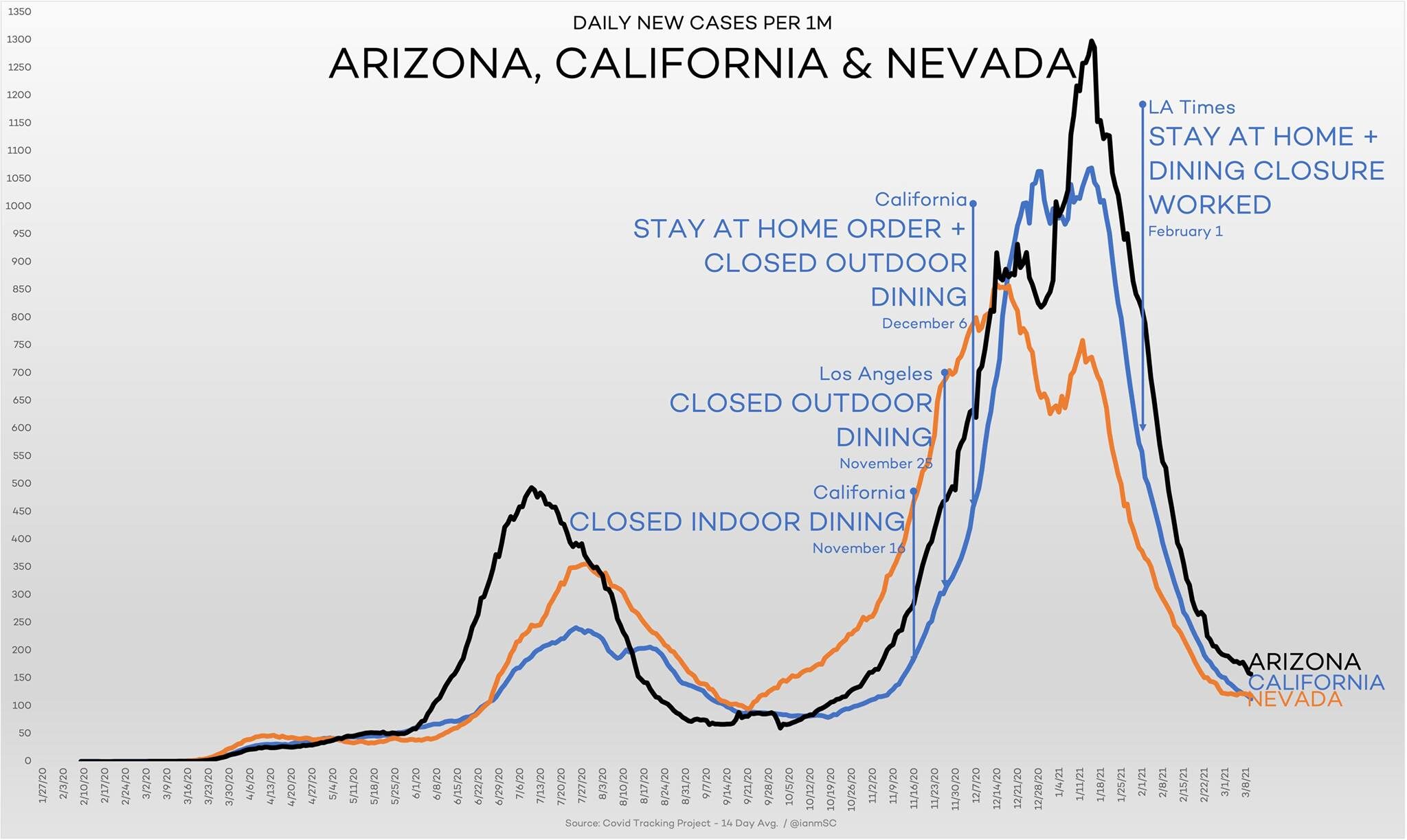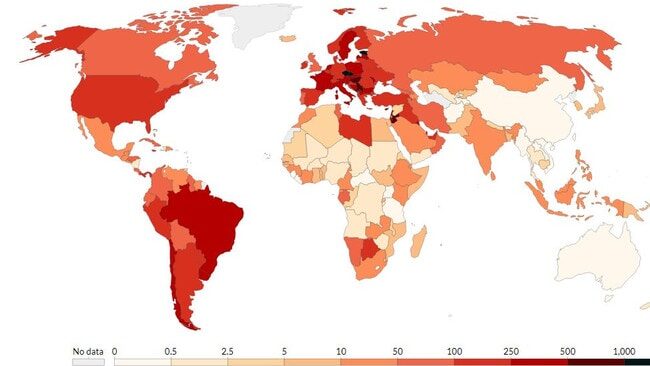
Experts had predicted chaos as a new variant of the coronavirus tore through the country of 60 million people at the start of the year, and doctors were bracing for the worst.
The strain — which appeared to be reinfecting people who had recovered from a previous bout of COVID-19 and raised serious questions about an impending vaccination rollout — was infecting nearly 22,000 people a day by the middle of January.
In a sign that health agencies were missing cases, one in three tests taken in January were coming back positive.
Adding to the uncertainty about how the nation would cope, thousands of holiday-makers returned home from their Christmas breaks leading to fears of a number of superspreading events being thrown into the mix.
At the second wave's peak, on January 19, there were 839 deaths linked to the disease in a single day.
But then, something remarkable happened.
The number of new daily cases fell off a cliff and the number of deaths linked to the virus naturally followed.
On the latest count overnight, South Africa recorded just over 1000 new cases and 65 deaths.
The incredible drop in cases and deaths is even more remarkable because it happened without a large-scale vaccination campaign or a strict lockdown.
Now, fewer than 5 per cent of tests are finding traces of the virus and the government has lifted most of its remaining restrictions.
The reason for the monumental turnaround is not clear.
Comment: There's a lot about the coronavirus that scientists just don't understand: Lack of 'important' genetic changes to Covid-19 in first 11 months surprises scientists
Other nations have seen cases suddenly drop without lockdowns too, but experts are beginning to piece together the reasons for this.
In India, for example, experts have suggested that many parts of the nationhave reached herd immunity or that Indians may even have some pre-existing protection from the virus.
Comment: India has also made hydroxychloroquine and other safe medications proven to protect and alleviate symptoms of the coronavirus available to people.
With the situation in South Africa, experts have basically thrown their hands in the air and admitted they do not know what has happened.
"Anybody who professes certainty (about why infections started dropping) is lying," Harry Moultrie, a senior medical epidemiologist at South Africa's National Institute for Communicable Diseases, told The Wall Street Journal. "There is so much uncertainty in all of this."
One trait that South Africa shares with other nations that have seen mysterious drop-offs in cases is the limit to its testing capabilities, meaning there is likely to have been a lot more cases than the official figures suggest.
It also took measures to stop the spread, with the government making masks mandatory, closing beaches, enforcing a nightly curfew, stopping large social gatherings and even banning the sale of alcohol.
Comment: And yet other countries that locked down, especially those that introduced the harshest measures, did not see cases drop, on the contrary, many saw cases rise and are now claiming that more lockdowns are needed because another 'wave' is coming: Germany may enforce ANOTHER lockdown amid claims of a 'third wave'
However, families were allowed to gather for Christmas and New Year, and the restrictions came after tens of thousands of South Africans working in big cities like Johannesburg had already travelled to see family in provinces where COVID-19 case numbers were growing.
The fears of superspreading events occurring as South Africans piled onto tightly-packed buses to return home after their holiday never materialised, and experts are still trying to figure out why.
Comment: After nearly a year of lockdowns, experts the world over are being forced to admit there is no evidence of 'superspreader' events.
Herd immunity is one suggestion, despite only about 1.5 million South Africans, around 2.5 per cent of the population testing positive.
The true number is likely to be much higher due to limits to the nation's testing capacity, but experts have cast doubt over whether it is high enough to point to herd immunity as a reason for such a sudden and uniform drop in cases on a national scale.
Comment: Note that the coronavirus has been circulating since at least the end of 2019: Chinese Govt: 'Covid-19 began as multiple separate outbreaks globally, we were just the first to report'
Dr Moultrie told The Wall Street Journal scientists were looking at the role of certain networks, or individuals with many social or work contacts, in driving and eventually slowing down localised outbreaks in South Africa.
Another issue experts are looking at globally is whether people are voluntarily making changes to their lifestyles that will reduce the spread of the virus, without the need for government enforcement.
While, experts try to piece the puzzle together in South Africa, the government has declared that the nation's second wave is over.
President Cyril Ramaphosa said at the end of last month that an evening curfew will remain in place between midnight and 4am, gatherings will be permitted subject to limitations on size and health protocols, and alcohol will be back on sale.
It has opened five international airports, but some land border posts remain closed.
While it remains to be seen what impact this will have on case numbers in the coming weeks, it is clear that the pandemic is far from over on a global scale.
Comment: Some states in the US have removed most of the restrictions and are still seeing cases drop:
Coronavirus cases are beginning to rise again worldwide, with a number of countries seeing their new infections surging in recent days and weeks.
In particular, Europe is seeing cases soar, with a third wave advancing swiftly across much of the continent.
Comment: The number of vaccine related side effects are also beginning to rise: 8 EU countries SUSPEND AstraZeneca's Covid vaccine amid reports of fatal blood clots
The total of worldwide cases have been slowly climbing in recent weeks, bringing up the seven-day average.
On February 20, global new cases dropped to their lowest number since the middle of October with 398,366 new cases recorded and a seven-day average of 360,664.
However, on the last count on March 13 new cases had climbed to 492,351 and the seven-day average to 442,494.
Many nations that were badly hit over the northern hemisphere winter like the US for example saw cases sharply drop through February, bur the drop has levelled off since the start of March with a seven-day average of around 61,400 new cases a day.
Comment: Like a seasonal flu? And notably the flu has been strangely absent: Flu cases 'drop' 98% around the world
However, there are many countries where cases are increasing, contributing to the upward curve of daily new cases worldwide.
The infection rate in the EU is now at its highest level since the beginning of February, with the spread of new variants of the COVID-19 virus being blamed for much of the recent increase.
Several countries are now set to impose strict new lockdown measures in the next few days.
Italy is set to reimpose restrictions across most of the country on Monday — a year after it became the first European nation to face a major outbreak.
There, authorities recorded more than 27,000 new cases and 380 deaths on Friday
Schools, restaurants, shops and museums will close with Health Minister Roberto Speranza saying he hoped the measures and vaccination program would allow restrictions to be relaxed in the second half of spring.
France meanwhile has recorded more than 26,000 new cases on the last count overnight. While the figure is a drop from 29,759 the day before, the situation in the nation's hospitals is worsening.
Those in intensive care units edged higher by 57 to 4127, while emergency resuscitation units were running at nearly 82 per cent capacity, the highest since late November.
The French government has so far resisted pressure from health experts to impose a new, third lockdown in the face of rising case numbers.
Instead it has imposed a 6pm nationwide curfew and weekend lockdowns in two regions struggling to contain outbreaks while big shopping centres have been required to close.
In Poland, 17,260 new daily coronavirus cases were reported on Wednesday, the highest daily figure since November. New pandemic restrictions are likely to be announced this week.
In Germany, 12,674 new infections were reported on Saturday, a rise of 3117 from the previous week, as the head of the country's infectious disease agency acknowledged that the country was now in the grip of a third wave.
According to John Hopkins University data, the worst affected nations per capita are in eastern and central Europe.
The Czech Republic is being hit the hardest with 1411 cases per one million people.
The country's case rates have put a massive strain on its public health system - on March 5, the Czech government announced publicly that it had asked Germany, Switzerland and Poland to take in dozens of COVID-19 patients, in order to ease the burden on Czech hospitals that were running out of bed space.
Comment: Dozens? Is that really what we understand to be the definition of a pandemic? And one wonders how strained Czech hospitals were in prior flu years, because the UK NHS has been struggling to cope every year for nearly a decade: NHS had 15% LESS patients this December compared to 2019 - Any crisis is due to budget cuts, staff shortages and excessive measures
The other worst affected nations include Estonia, Hungary, San Marino and Montenegro.






Comment: Why are European governments reimposing lockdowns - yet again - when previous lockdowns clearly did not work?